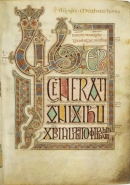| Genesis | Exodus | Leviticus | Numbers | Deuteronomy | Joshua | Judges | Ruth |
| 1 Samuel | 2 Samuel | 1 Kings | 2 Kings | 1 Chronicles | 2 Chronicles | Ezra |
| Nehemiah | Esther | Job | Psalms | Proverbs | Ecclesiastes | Song of Solomon |
| Isaiah | Jeremiah | Lamentations | Ezekiel | Daniel | Hosea | Joel | Amos | Obadiah |
| Jonah | Micah | Nahum | Habakkuk | Zephaniah | Haggai | Zechariah | Malachi |
| Tobit | Judith | Additions to Esther | Wisdom of Solomon | Ecclesiasticus | Baruch |
| Letter of Jeremiah | Prayer of Azariah | Susanna | Bel & the Dragon | 1 Maccabees |
| 2 Maccabees | 1 Esdras | 2 Esdras |
| Matthew | Mark | Luke | John | Acts | Romans | 1 Corinthians | 2 Corinthians |
| Galatians | Ephesians | Philippians | Colossians | 1 Thessalonians | 2 Thessalonians |
| 1 Timothy | 2 Timothy | Titus | Philemon | Hebrews | James | 1 Peter | 2 Peter |
| 1 John | 2 John | 3 John | Jude | Revelation |
 The Book:
The Book:
Is so called because it contains the history of the deliverance and government of Israel by the men who bore the title of the “judges.” The book of Ruth originally formed part of this book, but about A.D. 450 it was separated from it and placed in the Hebrew scriptures immediately after the Song of Solomon. The book contains,
- An introduction (Judg. 1 - 3:6), connecting it with the previous narrative in Joshua, as a "link in the chain of books."
- The history of the thirteen judges (Judg. 3:7 - 16:31) see table:
| Thirteen Judges | Years |
| FIRST PERIOD (Judg. 3:7 - 5) | |
| Servitude under Chushan-rishathaim of Mesopotamia | 8 |
| OTHNIEL delivers Israel-rest | 40 |
| Servitude under Eglon of Moab: Ammon, Amalek | 18 |
| EHUD's deliverance-rest | 80 |
| SHAMGAR | Unknown |
| Servitude under Jabin of Hazor in Canaan | 20 |
| DEBORAH [BARAK] | 40 |
| First Period total of years | 206 |
| SECOND PERIOD (Judg. 6 - 10:5) | |
| Servitude under Midian, Amalek, and children of the east | 7 |
| GIDEON | 40 |
| ABIMELECH, Gideon's son, reigns as king over Israel | 3 |
| TOLA | 23 |
| JAIR | 22 |
| Second Period total of years | 95 |
| THIRD PERIOD (Jdg_10:6-12) | |
| Servitude under Ammonites with the Philistines | 18 |
| JEPHTHAH | 6 |
| IBZAN | 7 |
| ELON | 10 |
| ABDON | 8 |
| Third Period total of years | 49 |
| FOURTH PERIOD (Judg. 13 - 16) | |
| Servitude under Philistines | 40 |
| SAMSON | 20 |
| Fourth Period total of years | 60 |
| Total of four periods | 410 |
Samson's exploits probably synchronize with the period immediately preceding the national repentance and reformation under Samuel (1Sa_7:2-6). After Samson came Eli, who was both high priest and judge. He directed the civil and religious affairs of the people for forty years, at the close of which the Philistines again invaded the land and oppressed it for twenty years. Samuel was raised up to deliver the people from this oppression, and he judged Israel for some twelve years, when the direction of affairs fell into the hands of Saul, who was anointed king. If Eli and Samuel are included, there were then fifteen judges. But the chronology of this whole period is uncertain.
The historic section of the book is followed by an appendix (Judg. 17 - 21), which has no formal connection with that which goes before. It records (a) the conquest (Jdg_17:1-13, 18) of Laish by a portion of the tribe of Dan; and (b) the almost total extinction of the tribe of Benjamin by the other tribes, in consequence of their assisting the men of Gibeah (Judg. 19 - 21). This section properly belongs to the period only a few years after the death of Joshua. It shows the religious and moral degeneracy of the people.
The author of this book was most probably Samuel. The internal evidence both of the first sixteen chapters and of the appendix warrants this conclusion. It was probably composed during Saul's reign, or at the very beginning of David's. The words in Jdg_18:30, Jdg_18:31, imply that it was written after the taking of the ark by the Philistines, and after it was set up at Nob (1Sa_21:1-15). In David's reign the ark was at Gibeon (1Ch_16:39).
Source: Christian Classics Ethereal Library. Original article from Easton's Bible Dictionary.
 Print this page
Print this page